The Tao of Creativity and the Book of Five Rings
Miyamoto Musashi’s Book of Five Rings is a fascinating and surprisingly helpful guide to creativity and practice.
Steven Pressfields The War of Art is a contemporary, beautiful, simple, practical guide to confronting the main challenge of creativity, which is the resistance the artist feels when beginning and finishing creative work. Pressfield describes in ways deeply familiar to any artist how self-sabotage and our fears and anxieties can be recognized and overcome. It’s a great book and anyone attempting to do good work for the betterment of self and others would find pragmatic and concrete ideas to encourage and enlighten. We will talk more about Pressfields body of work in future posts.
I read the The War of Art perhaps 10 years ago now and few books have as much direct, practical application for myself and many other artists. and I've returned to this book time and again.
And now I have a new book that is every bit as useful to understanding and refining my own approach to creativity that comes from 17th-century Japan.
Miyamoto Musashi’s Book of Five Rings is a beautiful, concise, pragmatic guide to mastery of strategy with swordsmanship and warfare and life and art. The book’s introduction clearly connects the development of mastery in one domain with mastery of any other domain":
“…the principle of strategy is to know ten thousand things from a single thing.”
Joe Rogan often mentions this book and this idea on his podcast as profoundly influencing him as a young man. Hearing this mentioned a few times I decided to give it a read. It’s not a long book and not hard to read and will inspire useful reflections on learning, honing, and mastery.
This book is one I will return to from time to time.
As with Leonardo Da Vinci’s A Treatise on Painting, there are simple and immediately applicable ideas that transcend the genre of learning strategy and warfare.
Musashi was also an artist that honed his abilities as a calligrapher. There is no question that the ideas in the book are applicable to creative work. One could simply imagine that when Musashi talks about strategy, he is talking about creativity and creative approach.
There are 9 principles in the beginning of the book that are quite beautiful that I will focus on.
Miyamoto Musashi writes:
“Those who would like to learn my strategy should apply the following rules in order to practice the way.”
Each principle is simple to understand, challenging to master and infinitely valuable when lived and learned.
The 9 principles:
Think of that which is not evil
Train in the way
Take an interest in all the arts
Know the way of all professions
Know how to appreciate the advantages and disadvantages of each thing
Learn to judge the quality of each thing
Perceive and understand that which is not visible from the outside
Be attentive even to minimal things
Do not perform useless acts
As photography is a primary craft I am learning, I will discuss the applications of these principles to photography. Most of these principles I already practice to a degree, but the concise articulation here in the Book of Five Rings is helpful and useful because they describe in a new way ancient truths. They struck a chord with me.
The first: Think of that which is not evil.
This idea is ancient, found in the Bible, Old and New Testaments, and other ancient texts. What we fill our minds with is the source of our own becoming. Managing the noise of our minds and finding the beautiful signal within and without is a struggle and practice that forms our perspective and values.
In the New Testament, Philippians 4:8, Paul writes:
“In conclusion, my friends, fill your minds with those things that are good and that deserve praise: things that are true, noble, right, pure, lovely, and honorable.”
Same idea, different vantage point. There is good and there is evil and we can cultivate a relationship with the good and true and we must.
Years ago when I decided to pursue photography with the best of myself I began a practice of viewing visual arts and curating for myself those artists that resonated with me. It’s now a daily practice that I use to form my own perspectives, consciously and unconsciously.
Reading too is such a practice, and the Book of 5 Rings is one such good book that is “not evil.” Music, prayer, church, conversation, photography, exercise, etc, are all avenues to walk toward the good and away from evil.
Train in the way
When Musashi talks of “the way” he is likely referencing the writing and philosophy of the Tao Te Ching.
On a practical level, here we are reminded that the way is learned through walking, through training, through doing, through careful reflection. As Musashi reminds the reader throughout his book, reading and listening are not enough to understand his ideas.
Understanding comes through continual training and study and application.
After many key ideas in the book Musashi will say: “Ponder this well” or “This should be examined well” or “Reflect well on this.”
There is no end to the walking of the way, to training in the way. Mastery is a road stretching out long before us.
Musashi writes:
“Follow a road that is a thousand leagues long one step at a time.”
“Be victorious today over what you were yesterday; tomorrow be victorious over your clumsiness and then also over your skill. Practice in accordance with what I have written without letting your mind deviate from the way.”
This framing of being victorious over what you were yesterday brings the development of mastery into the everyday beautifully. Small steps accomplish long journeys.
Take an interest in all the arts
This too is an idea I’ve incorporated into my own practice. Painting, music, poetry, literature, philosophy, theology and every other arena of artistic endeavor provide context to one’s own practice. How one artist proceeds, how one artifact inspires, all inform one’s own artistic endeavor. We may learn from all domains and a well-educated, broad perspective on the different arts is endlessly useful for learning a creative endeavor.
A book about swordsmanship may well help one build a business, write a book, make a photograph.
Know the way of all professions
Musashi compares the work of a soldier and carpenter to demonstrate that strategy is developed within many fields, many professions and learning one will inform learning another. Being able to extract learnings from other fields artistic and otherwise is useful.
Decades ago it became nearly impossible to be a master of all the scientific arts. The depth of knowledge is great and perhaps greater than times past. Examples might be, biology, mathematics, physics, computer science, or electrical engineering.
Perhaps it’s not possible to know the way of all professions but we take a broad view within a range of professional domains that will inform our own journey. Narrow specialties don’t need to be the sole focus of one’s life and work.
Musashi writes:
“Without knowing others, one cannot really know oneself.”
Know how to appreciate the advantages and disadvantages of each thing
There are pros and cons to everything and learning to tell the difference is key. There is an old Christian catechism book from the 1st or 2nd Century AD that begins with these words:
“There are two ways, one of life and one of death; but a great difference between the two ways.”
There are ways of cultivating life and death in all areas of life and we get to choose. Our choices are only possible if we meditate on the useful and useless, the advantages and disadvantages. There is a big difference between the two.
So it is with the arts. There are artists that maximally communicate their vision having learned how best to craft and present their work. And some artists take many things for granted.
One way I’ve practiced my appreciation of each thing is by reflecting through writing on particular works of art, generally photographs. What lens was used? What’s the exposure time? What’s the impact?
To differentiate well is a core skill.
Learn to judge the quality of each thing
Along with differentiating, perceiving the qualities of everything allows for strategic engagement. How to incorporate discordant elements within a creative project requires discernment of the qualities of each element.
As a painter selects color, shape form, so a photographer chooses values of exposure, perspective, framing, lens, and much more.
My own approach to this is to educate myself and form my perspective through viewing and reviewing the great works of art and science and relating to them. There is often an internal response, a feeling that arises within me, a positive resonance. This is the signal to me that there is something worth sitting with.
Then attaching language to these internal moments of awareness and connection allows me to relate and articulate the qualities of the object.
I hope to get beyond questions of liking or disliking and into the more specific domains. Exploring descriptive metaphors are fun way to ascribe qualities. Talking about a glass of wine as if it were a human or thinking about a piece of art as an element of the natural world helps to flesh out one’s senses.
Perceive and understand that which is not visible from the outside
There is a subterranean waiting to be explored and it’s always informing the surface. There are depths to exploring all things.
When exploring Big Sur, seeking out the unseen is great fun. Caves, underground currents, glimpses of ancient seabeds, the canyons in the mountains, the freshwater ways all are pathways to the not visible and there is much to be learned that rounds out the picture of the whole.
So often there are hidden roots, hidden foundations, hidden pathways that inform our lives and the world about us. Tracking the roots we find the wellspring of our being and the pathways of our becoming.
So it is with the 10,000 things, as Musashi writes:
“…the principle of strategy is to know 10,000 things from a single thing.”
We can focus on understanding what is above, below and before us, and through deep learning and reflection the keys to understanding many things become ours.
Be attentive even to minimal things
The world is a macrocosm, we are a microcosm. The patterns that govern the whole world are able to be witnessed in the smallest of things.
The smallest of things can have a significant impact on the whole at any moment.
Paying attention to microcosm in photography reveals a level of beauty I find astounding, and rewarding to witness and represent. In putting together a photo book on Big Sur, microcosm is a major theme.
A delightful aspect of the variety of preserves within Big Sur is that one park contains many pieces of the whole and becoming intimately familiar with one park will provide a good understanding of the Big Sur whole. Garrapata State Park is a great example, or Andrew Molera, or Pfeiffer, or Lime Kiln…you get the idea. Mountains meeting the sea, redwoods, creeks, waterfalls, beaches, all wrapped up in beautiful packages waiting to be searched out.
Often when on longer outings in the Big Sur backcountry, it’s the small scenes that delight me most. There may well be an amazing waterfall for a destination, but the decomposing leaf lit just right with reflective light brings a surprising joy, a joy I revisit as I find new and interesting subjects that resonate.
Do not perform useless acts
Of all the principles, this may be the most useful and difficult. How our modern lives are filled with so many useless avenues.
We’ve all explored some. None of us have explored all.
Filtering the noise out of our actions makes space for the signal-producing creative acts.
Years ago I stopped all subscriptions to online services. I minimize social activities.
Cultivating useful habits and pulling the behavioral weeds is a long road that stretches endlessly before us. One step at a time!
The internet is filled with trash that satisfies very little and managing our relationship to the deep cesspool is critical.
When it comes to the pulling the weeds of our behavior, I found this idea from Musashi helpful:
It is appropriate to understand details on the basis of a broad vision, and to attain depth by beginning on the surface.
If we have a goal for ourselves of mastery in a domain, we can begin with the obvious, and layer by layer, work towards the depths of understanding. By cultivating healthy habits and shedding useless ones, we begin in the place, on the surface. And there is no end to the depths we can go, step by step.
In closing, a final thought from Musashi:
“Examine these writings and train well.'“
“If you practice diligently from morning till night, the way of strategy, I teach your mind will spontaneously broaden.”
The Book of 5 Rings is excellent, and I will return to discuss the other chapters. It’s a good book. Recommended!
The photographs I include here are studies of light and water, two subjects that interact beautifully on many levels, far away and close up.

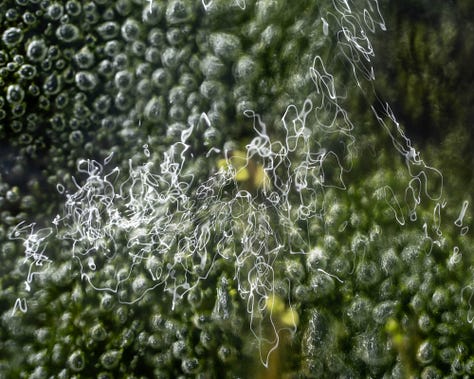
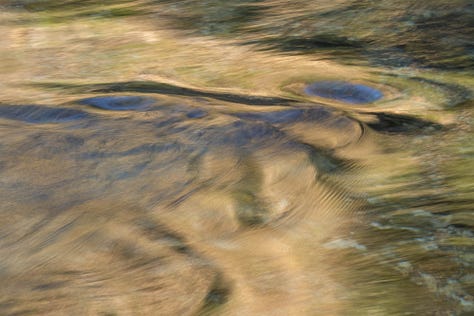
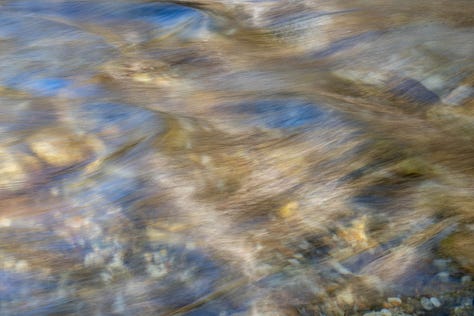
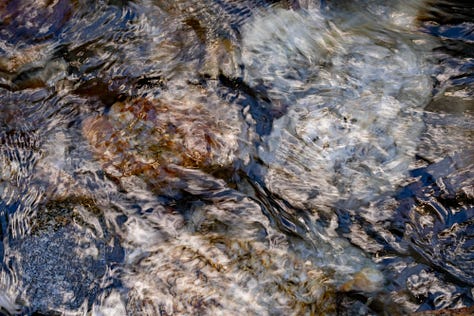
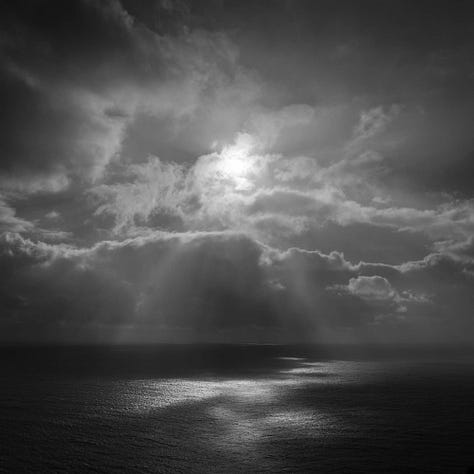





Thanks for your thoughtful pieces. I enjoyed reading it on your once a year day! The color on photos popped. Cheers!